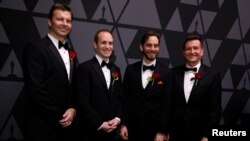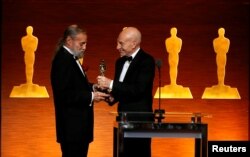"I am not a great fan of violence, of explosions," said actor Patrick Stewart shortly before he hosted the annual Scientific and Technical Awards Feb. 10, when engineers and technologists were honored several weeks ahead of the regular Oscar presentation.
"But some of the more subtle, sensitive, and beautiful aspects of what science, engineering and technology have provided for us," Stewart said, "leaves me gasping." He gave as an example one of this year's leading Oscar contenders, The Shape of Water, which uses a 3-D animation system called Houdini.
The creators of that movie-making tool, Mark Elendt and the company Side Effects Software, received Oscars for the system at the Academy's annual Scientific and Technical Awards in Beverly Hills. "It's a little bit surreal because I'm not an actor," said developer Elendt outside the ceremony, "and yet I'm getting a statue from the Academy."
Most of the dozens of awardees were given Academy plaques or certificates, an honor short of an Oscar, but still a major accomplishment in the movie industry.
Another team behind the same Houdini software received Academy plaques. The software is widely used in action films, explained developer Cristin Barghiel, "melting things, destroying them, putting them back together, having characters that morph because they're made out of lava or they're made out of gold ... that's phenomenal," he said. "This is not work for us," he added, pointing to the mathematicians and engineers on his team.
Other honorees included developers of several software "rigging" systems that create skeletal grids used to animate the movements of characters, including one from the company Rhythm & Hues. Awardee Hans Rijpkema said the software was used in The Chronicles of Narnia, The Lion, the Witch and the Wardrobe, Life of Pi, Night at the Museum, Alvin and the Chipmunks, Golden Compass, many, many movies over the years.
Some winners were honored for mechanical systems. Brad Hurndell was part of a team that developed a stabilized camera mount, which he explained is mounted on helicopters and has been used in "Transformers, X-Men, James Bond [films], the Fast and the Furious," and many other productions.
Bill Spitzak and Jonathan Egstad were winners for compositing software that combines multiple elements into a single scene, a digital system used to place actors against an exotic background. The system, called Nuke, was used for scenes at sea in the 1997 blockbuster Titanic.
Spitzak notes that compositing has been done since the early days of movies, but digital systems allow greater experimentation because filmmakers "can look at it and see exactly what they're going to get rather than have to wait until [the film] comes back from being developed." He says the software can also perform multiple steps at once, saving time.
An Oscar for technological contributions to the movie industry, called the Gordon E. Sawyer Award, went to a veteran who has seen major shifts in visual effects over the decades. Jonathan Erland worked with motion control and models on the original Star Wars film, released in 1977, and continues to work on cutting-edge technology.
Accepting his Oscar statuette, Erland reminded his colleagues of the central role of technology in the early days of movies, and of the movie academy, as the industry was developing new film stocks and transitioning from silent to sound films in the late 1920s.
Stewart said outside the ceremony, filmmakers today are "creating by technology whole worlds, which we weren't quite able to do" in the 1980s and 90s, when he worked on the series Star Trek: The Next Generation and its followup movies.
The changing science of motion pictures takes center stage each year in this nod to inventors and engineers. The regular Oscars will be presented to the artists who make the movies on March 4.

